Rainy days don’t have to mean staying indoors. With the right gear, especially a quality Bike Riding Rain Jacket, you can embrace cycling in the rain and even find a unique joy in it. Just like the childlike happiness of splashing in puddles, biking in the rain can be exhilarating, provided you’re prepared to stay dry and safe. This guide will cover everything you need to know about choosing the perfect rain jacket and other essential gear for comfortable and dry bike rides in wet weather.
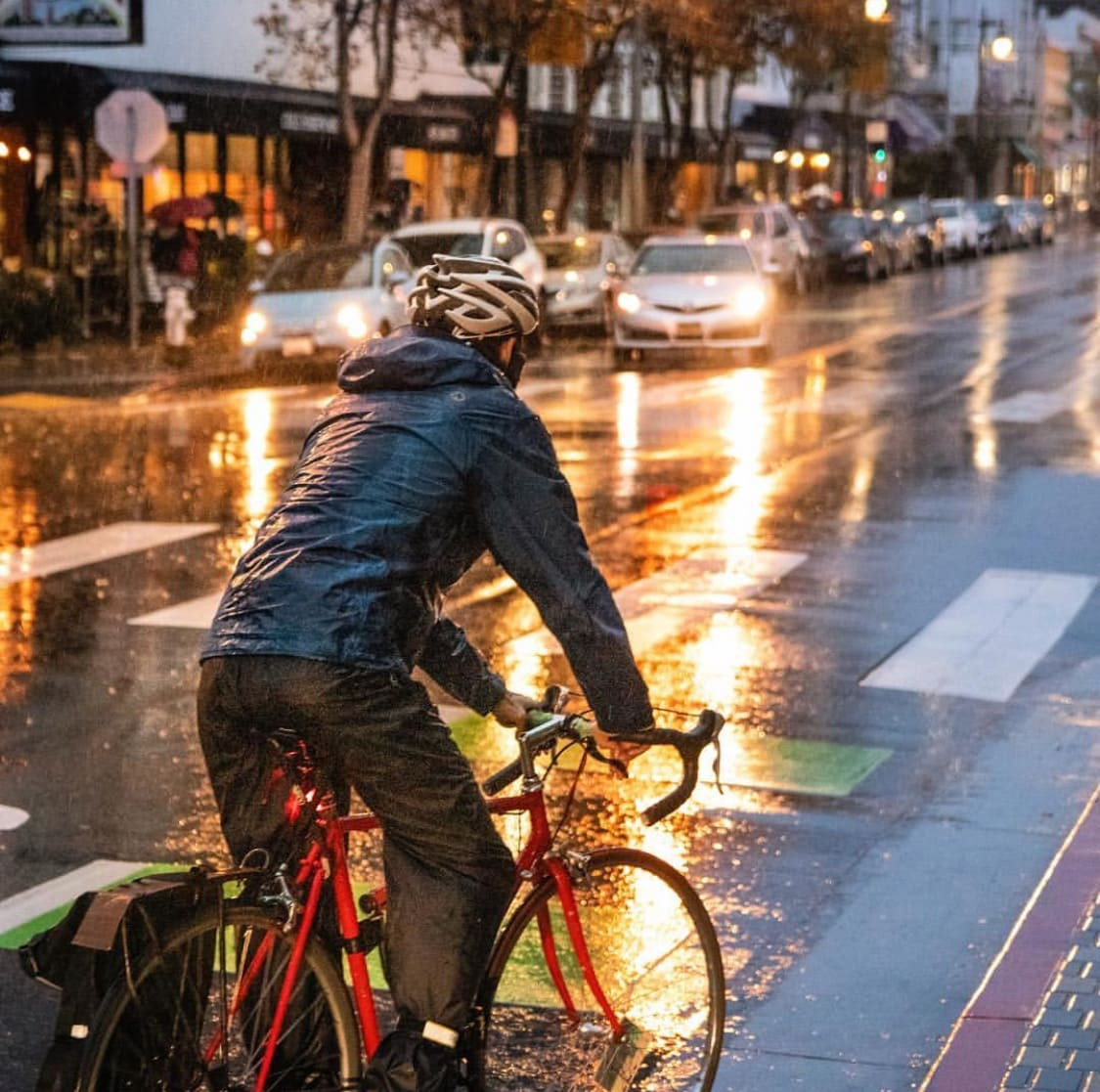 Someone on a bicycle with a downpour of rain happening around them. They are wearing full rain gear, highlighting the effectiveness of a bike riding rain jacket.
Someone on a bicycle with a downpour of rain happening around them. They are wearing full rain gear, highlighting the effectiveness of a bike riding rain jacket.
Before diving into rain jackets, remember that safety is paramount when cycling in the rain. Always ensure your bike lights are working for visibility and reduce your speed to account for slippery conditions. And while you’re getting your gear ready, let’s start with bike fenders, your first line of defense against road spray.
Bike Fenders: Your First Defense Against Wet Roads
Even after the rain stops, roads remain wet, and without fenders (mudguards), your tires will spray water and road grime directly onto you. Fenders significantly enhance your comfort and keep both you and your bike riding rain jacket cleaner during and after rain.
Choosing fenders can seem complicated due to the variety available. They come in front and rear options and various styles. Consider your bike type and any accessories like rear racks that might affect installation.
Easy Install Clip-On Fenders
Clip-on fenders are incredibly convenient for their tool-free installation and removal. Ideal for cyclists who only need fenders occasionally, they can be easily stored in a bag and attached when rain threatens.
SKS clip-on fenders are popular for their ease of use and effectiveness. Options include the SKS Raceblade Pro XL set and the Xtra-Dry rear mudguard.
Ass Savers offer a minimalist approach, providing basic protection with simple, foldable plastic designs.
 Ass Savers clip-on bicycle fenders, including a regular size Ass Saver and an Ass Savers Fendor Bendor, demonstrating portable rain protection for bikes.
Ass Savers clip-on bicycle fenders, including a regular size Ass Saver and an Ass Savers Fendor Bendor, demonstrating portable rain protection for bikes.
Permanently Attached Fenders
While installation might be more involved, permanently attached fenders offer continuous protection and increased security against theft. They are a great option if you frequently ride in wet conditions.
REI and Amazon offer a wide selection of permanent fenders, sortable by tire width to ensure a proper fit for your bike.
Detachable Fenders with Brackets
These fenders strike a balance, featuring fixed brackets for easy fender removal when not needed. The SKS Raceblade Long is a notable example, offering a secure fit with detachable fender sections.
DIY Fenders
For the resourceful cyclist, DIY fenders are a budget-friendly and creative solution. Materials like plastic bottles or even cardboard can be fashioned into effective fenders using zip ties. Rear racks can also offer some mudguarding if their design is solid and wide enough.
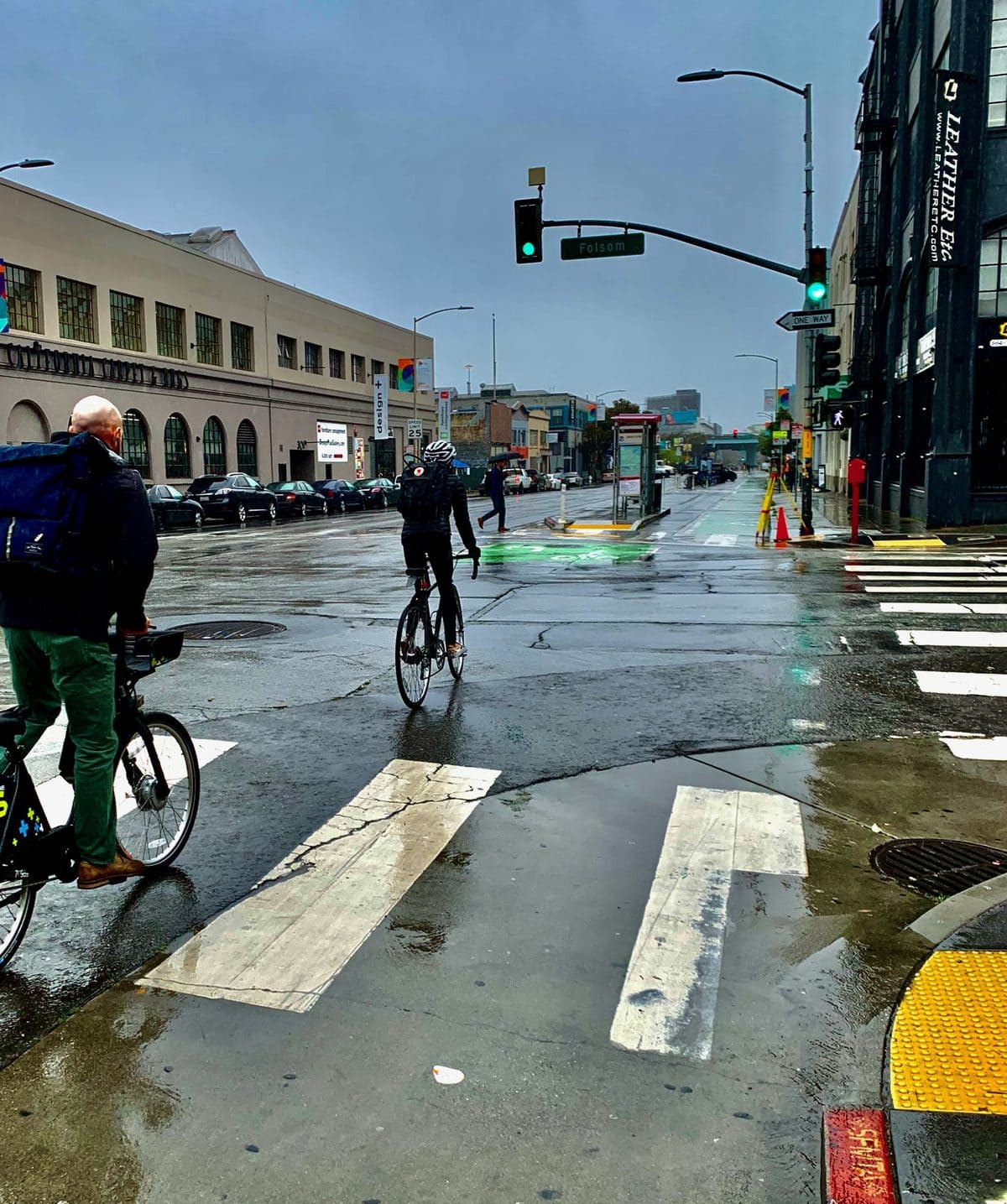 Two cyclists riding in a bike lane on a wet road after rain, showcasing different fender styles and levels of rain gear.
Two cyclists riding in a bike lane on a wet road after rain, showcasing different fender styles and levels of rain gear.
Bike Seat Covers: Protecting Your Saddle from the Rain
Depending on your bike seat material and whether you wear rain pants, a bike seat cover is a worthwhile investment to keep your seat dry. A simple plastic bag can also do the trick in a pinch. Waterproof saddles can be wiped down, but absorbent materials will require a cover to prevent a soggy ride.
 A cyclist in a rain jacket standing with a touring bicycle equipped with waterproof panniers and a seat cover, illustrating comprehensive rain gear for bike riding.
A cyclist in a rain jacket standing with a touring bicycle equipped with waterproof panniers and a seat cover, illustrating comprehensive rain gear for bike riding.
Weather Radar Apps: Plan Your Ride Around the Rain
Before heading out, checking a weather radar app can help you find rain-free windows for your bike ride. Radar provides more precise, localized information than general weather forecasts, allowing you to strategically time your ride and minimize exposure to rain.
Fast Drying Clothes: For Light Rain and Drizzles
For light rain or drizzles, fast-drying clothing can be sufficient. Materials like chinos or technical hiking pants dry quickly, keeping you comfortable even if you encounter unexpected showers. Similarly, fast-drying shirts and water-resistant shoes can enhance your comfort level in light rain.
Rain Jacket or Rain Poncho: Essential Upper Body Protection
A bike riding rain jacket is a fundamental piece of rain gear. It provides essential protection for your upper body and can even shield a backpack in light rain. For milder rain, a basic rain jacket might be all you need. Higher quality jackets offer better breathability, reducing sweat buildup, while more affordable options can still provide adequate water resistance.
 A cyclist in the rain wearing a wet rain jacket, highlighting the importance of jacket waterproofing and maintenance.
A cyclist in the rain wearing a wet rain jacket, highlighting the importance of jacket waterproofing and maintenance.
Rain ponchos or capes are alternatives to rain jackets, offering more ventilation and airflow, which can be beneficial to prevent overheating. Some bicycle-specific ponchos are designed to cover your handlebars. However, ponchos typically offer less leg protection compared to rain pants.
Rain Pants or a Rain Skirt: Leg Protection for Wet Rides
Waterproof rain pants are a game-changer for cycling in the rain. They provide significant comfort and dryness, especially for longer rides or heavier rain. Look for rain pants with pocket slits for easy access to your pockets underneath.
For safety, especially without a chain guard, use an ankle strap to prevent your rain pants from catching in the bike chain. Rain skirts or kilts are also available as alternatives to pants, offering easier removal over shoes.
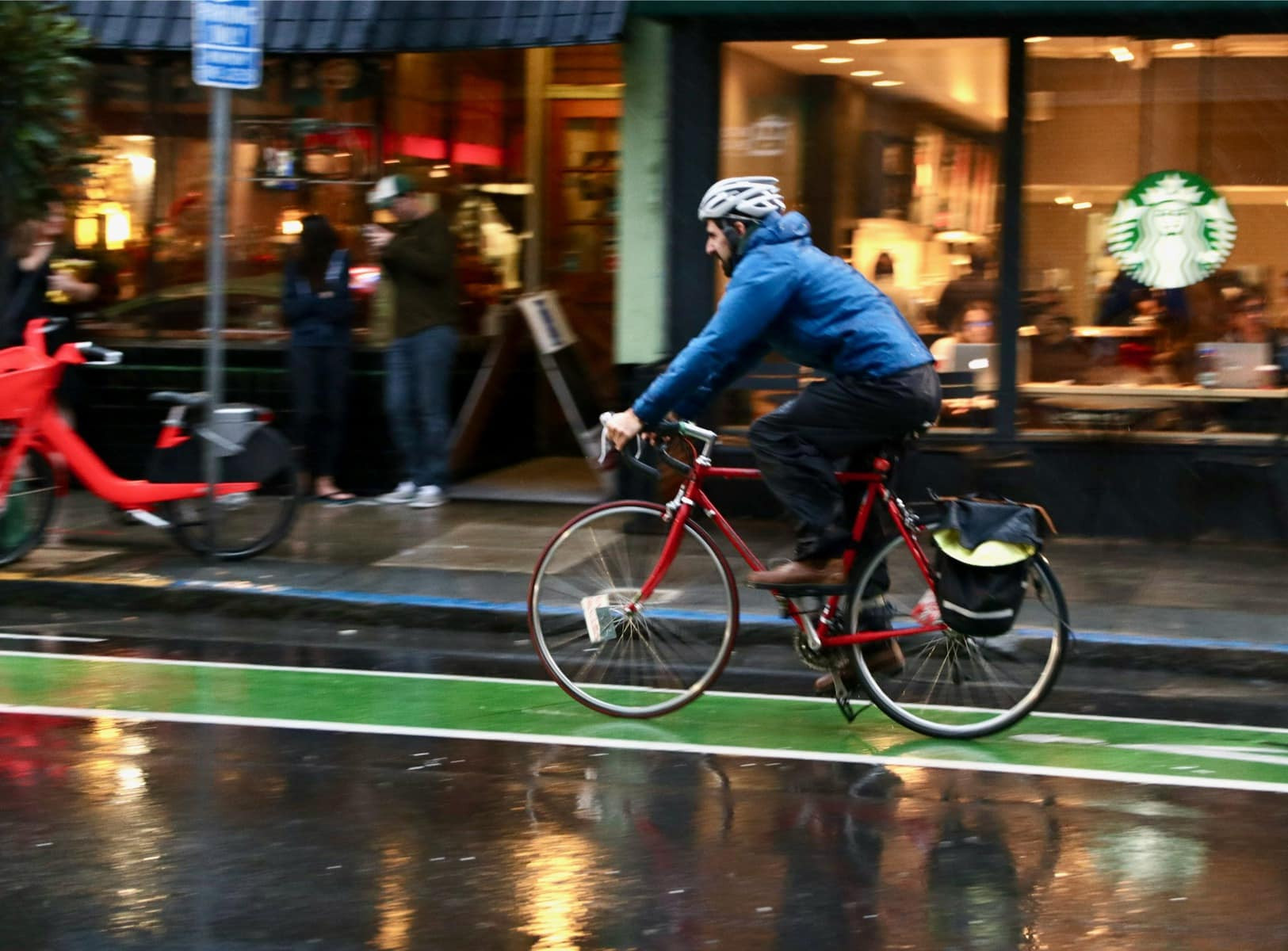 A cyclist on a road bike in a bike lane wearing a rain jacket and rain pants, demonstrating full coverage rain gear for cycling.
A cyclist on a road bike in a bike lane wearing a rain jacket and rain pants, demonstrating full coverage rain gear for cycling.
Protect Your Shoes and Socks: Keeping Your Feet Dry
Once your legs are protected by rain pants, water runoff will likely target your shoes. Waterproof socks are an excellent base layer, ensuring dry feet even if water seeps into your shoes. For shoes, you have two main options:
Waterproof Shoes
Waterproof shoes provide the simplest solution for dry feet. No need for extra covers or changes. Boots like Blundstones, while not fully waterproof, offer good water resistance, especially when paired with waterproof socks. Waterproof hiking shoes and Gore-tex shoes are also reliable choices.
Shoe Rain Covers or Galoshes
For cyclists who prefer specific footwear for fashion or function, rain shoe covers or galoshes offer waterproof protection over regular shoes. Clear shoe covers are available for those wanting to maintain some visibility of their footwear.
Keep Your Head and Face Dry: Enhancing Comfort and Visibility
With a bike riding rain jacket, rain pants, and waterproof shoes, you’re well-equipped for wet rides. To further enhance comfort, consider head and face protection:
Hair
A simple shower cap under your helmet is an effective way to keep your hair dry without being noticeable. Rain jacket hoods also help, though they can reduce visibility and be blown back by wind. Experiment with wearing your hood under or over your helmet to find your preference.
Face, Eyes, & Makeup
A visor is crucial for keeping rain off your face and out of your eyes. A baseball cap under your helmet or a helmet visor works well. Cycling caps offer visors but may be shorter. Clear glasses protect your eyes from rain, though droplets can obstruct vision. Consider anti-fog spray for glasses and waterproof makeup if necessary.
Waterproof Gloves: Warmth and Dryness for Your Hands
Rain often brings colder temperatures, making waterproof gloves essential. Leather gloves with touchscreen compatibility offer some water resistance for lighter rain. For guaranteed dryness and warmth, opt for dedicated waterproof gloves. For extreme cold, consider Bar Mitts, handlebar-mounted hand covers, for maximum protection.
Keeping Your Things Dry: Protecting Your Belongings
For commuting or errands, waterproof bags are crucial to keep your belongings dry.
Waterproof Bike Bags
Waterproof bicycle panniers mounted on a bike rack are ideal for carrying cargo in the rain. Ortlieb Backrollers are a popular, highly waterproof option. For baskets or crates, use basket covers, liners, or dry bags. Backpack rain covers can also double as basket covers.
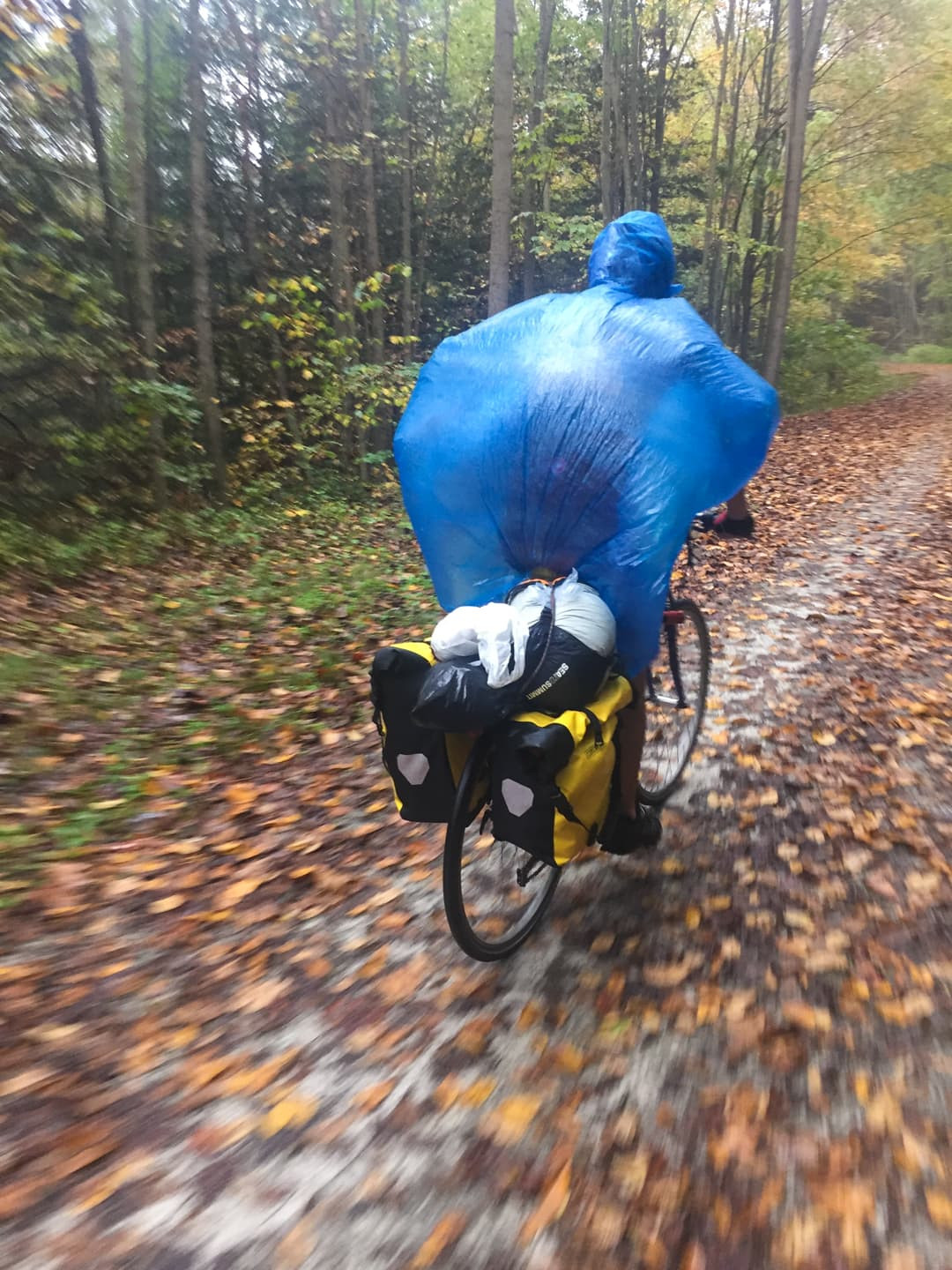 Waterproof Ortlieb Backroller panniers and a rain poncho on a bicycle, demonstrating effective gear for keeping both rider and belongings dry.
Waterproof Ortlieb Backroller panniers and a rain poncho on a bicycle, demonstrating effective gear for keeping both rider and belongings dry.
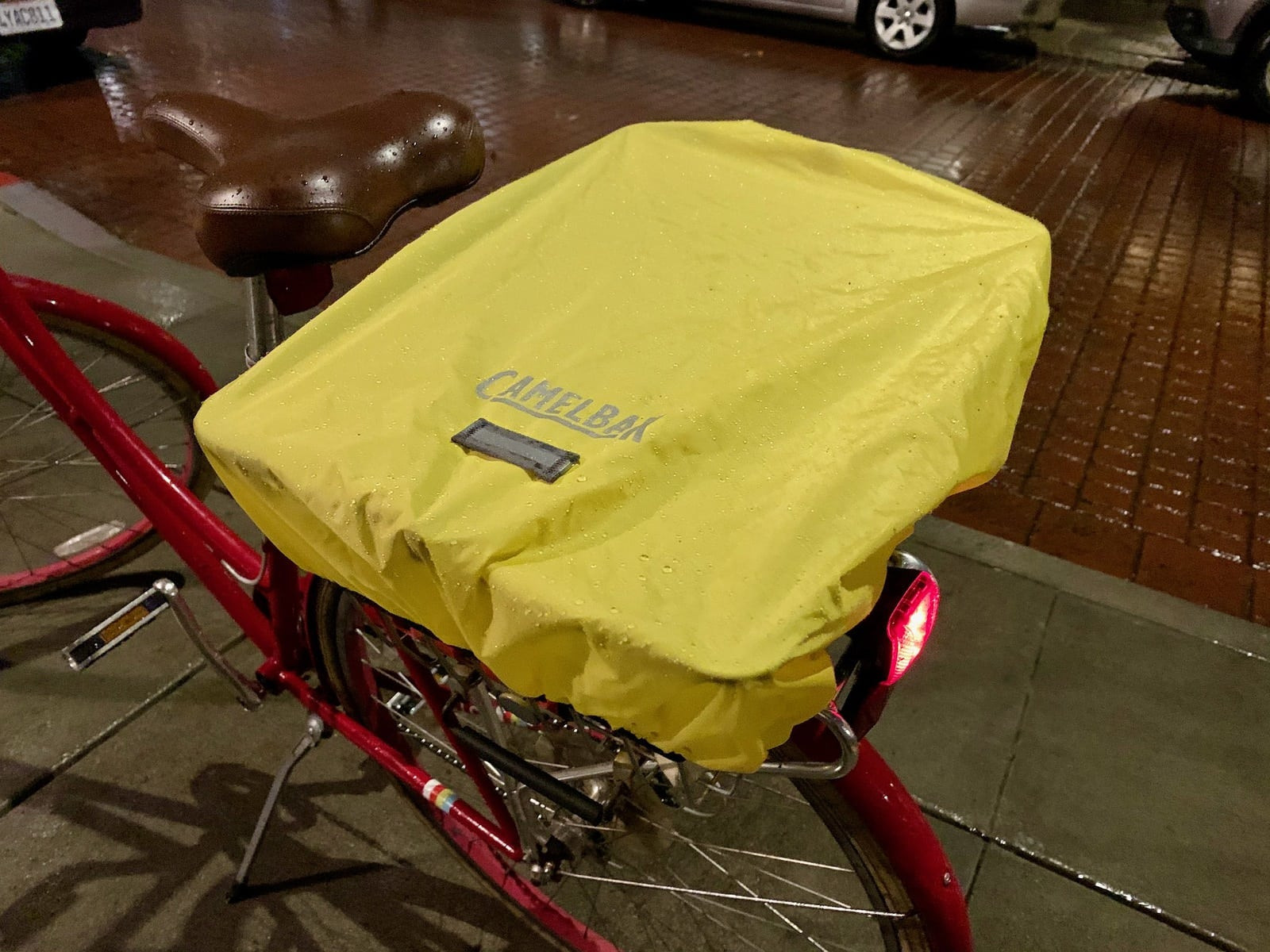 A backpack rain cover used to protect items in a bicycle basket from rain, showcasing a versatile solution for keeping belongings dry while cycling.
A backpack rain cover used to protect items in a bicycle basket from rain, showcasing a versatile solution for keeping belongings dry while cycling.
Backpack Rain Cover
For shorter trips, a backpack rain cover provides reliable protection for your backpack. Alternatively, in a pinch, wear your rain jacket over your backpack for some level of shielding.
(Re)Waterproof Your Rain Gear and Clothes: Maintaining Performance
Over time, the Durable Water Repellent (DWR) coating on rain gear wears off, causing jackets and pants to “wet out.” Regular use, especially with backpacks, accelerates this process. To restore water resistance, re-waterproof your gear with DWR sprays or washes. This simple maintenance can significantly extend the life and performance of your bike riding rain jacket and other waterproof items.
Embrace the Rain: Enjoy Your Wet Weather Bike Rides
With the right bike riding rain jacket and other essential gear, you can confidently and comfortably cycle in the rain. Embrace the unique experience of a rainy bike ride, and remember to ride cautiously, especially on slippery surfaces.
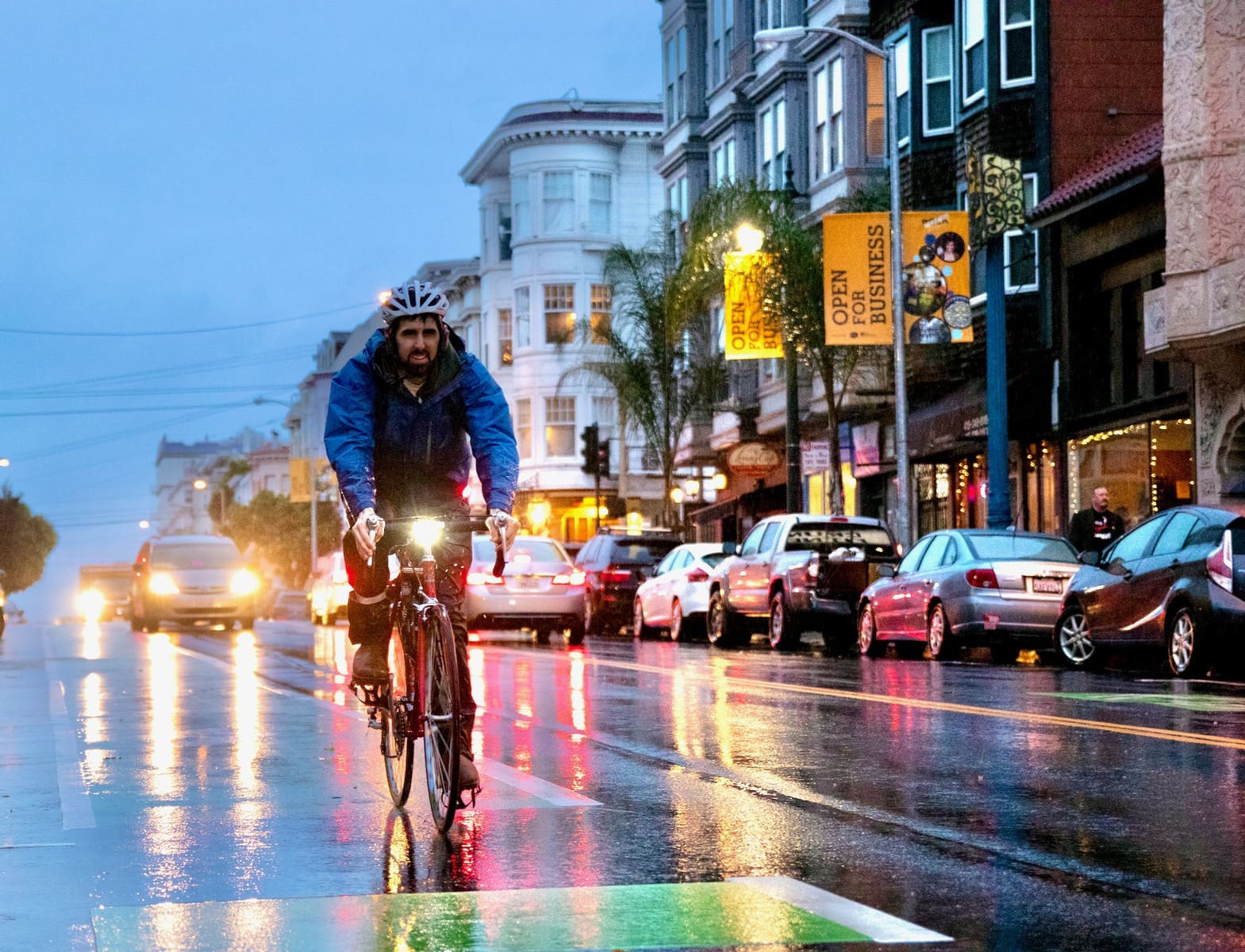 A cyclist riding towards the camera in full rain gear on a wet bike path, exemplifying preparedness and enjoyment of bike riding in the rain.
A cyclist riding towards the camera in full rain gear on a wet bike path, exemplifying preparedness and enjoyment of bike riding in the rain.
What’s your go-to rain gear for cycling? Share your favorites in the comments below!
